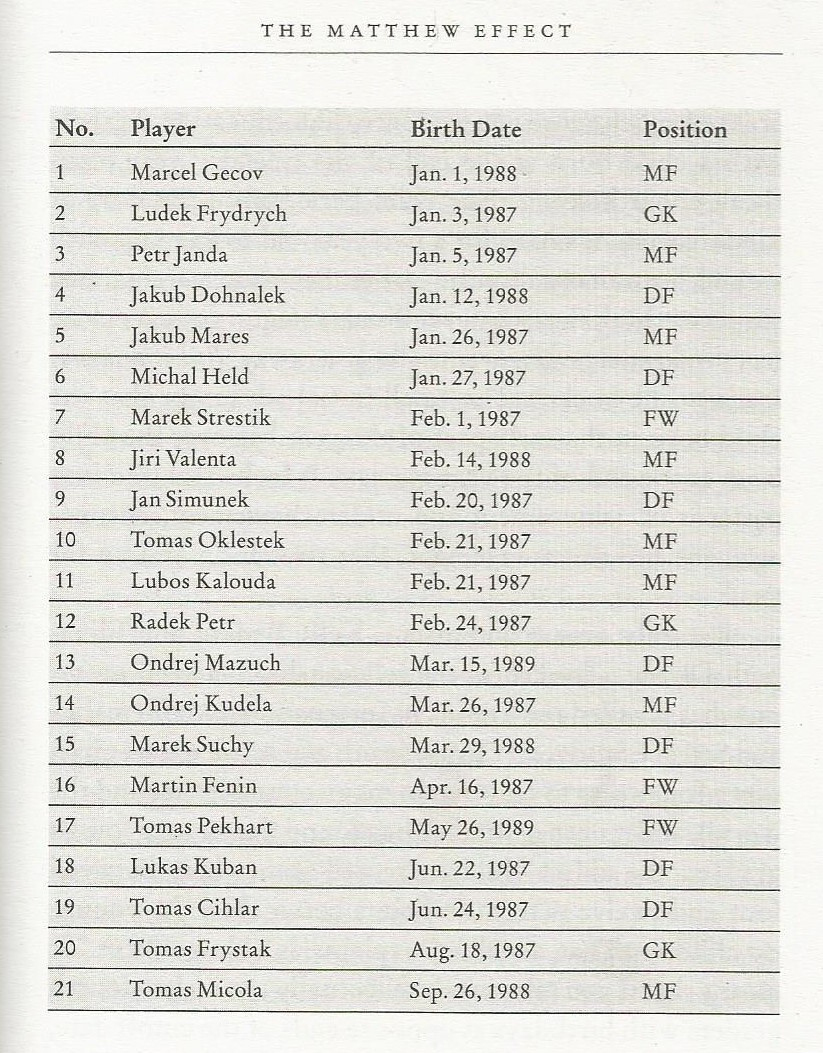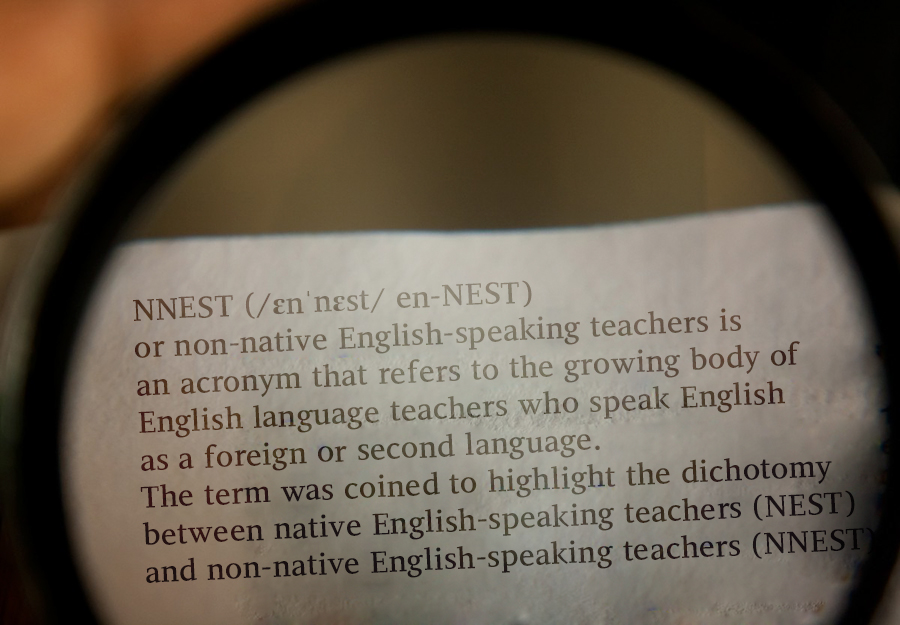Look at the following table (Gladwell 2008 – p. 27). This is the roster of the 2007 Czechoslovakian National Junior soccer team which actually got to the World Cup finals. Do you notice anything? That’s right. Nearly 75% of all players were born in January, February and March! The odds of such a thing happening by chance are astronomically low. Nor was this an isolated incident. What does it mean? Is it that children born in those months are somehow endowed with superior athletic prowess? Is it their star sign that helps? And what could such a phenomenon possibly have to do with NNESTs?!? Read on.
By Nick Michelioudakis, AdvDipEd – MEd – EdDoctorate

How to succeed as an athlete
How does this happen? It’s very simple. In most countries, young players are grouped in cohorts depending on their age. The age bracket is one year. In most cases the cutoff point is January the 1st. When coaches start scouring the country for new talent, they look at the different cohorts separately – and they start looking at them when they are really young. At the age of 8 or 9 a few months can make a real difference in how big, strong, fast and coordinated someone is. So naturally, it is mostly kids who were born at the beginning of each year that get chosen. ‘But surely’ you might say ‘this initial minor difference just disappears after a few years – when all the kids are fully grown’. Yet here is the thing – it doesn’t! Look at the table again. You will notice that most players were born in 1987 and 1988 – yet the World Cup took place in 2007; the players were about 20 years old! Why had the initial pattern not changed? According to Gladwell, it is all down to that initial selection. Young kids who are chosen get much better coaching and, crucially, they get to play a lot more than the other kids. Gradually, what starts as an insignificant difference, sure to disappear after a few years, becomes a real difference in ability. In later screenings, the same players get chosen again – and this time they really are better. Here is Malcolm Gladwell giving us a similar example from Hockey:
This is the mechanism which I call ‘The Magnifier’: Some people get selected for ‘higher things’ on the basis of some small difference (real or imagined). The opportunities that result from this actually do make them better over a period of time. Gladwell also gives figures about another sport – baseball. The pattern is the same. It is hard to argue with the evidence. [NB: Notice that there is no prejudice or stereotyping in the selection of the athletes; they are chosen purely on merit. When a coach watches kids play s/he cannot tell immediately when they were born. But what about Men and Women? Or NESTs and NNESTs?].
A (slightly) different explanation for the glass ceiling
I would like to argue that the same mechanism can explain a number of differences that we see all around us. Take women for instance. In 2011 women made up less than 4% of CEOs in Fortune 500 companies and held fewer than 17% of seats in Congress (Gneezy & List “The Why Axis” – p. 35) and that despite all the progress that has been made over the years in the field of gender equality. How are we to account for this?
‘Naturally’ (this is meant to be ironic) people associate top positions with men. Steinpreis, Anders and Ritzke sent CVs for an academic tenure-track job to 100 university psychologists. The CVs were identical except for one difference: half of them were by Dr Brian Miller and the other half by Dr Karen Miller. Results: 75% thought the former was good enough, but just under 50% thought the latter had what it takes (Steinpreis et al. 1999). 1 Unlike what happens in sports, stereotypes are very much present when it comes to men and women – and they are triggered instantly.
And then what happens? If I am a CEO and I think that my male managers are ‘higher flying’ than my female ones, I tend to invest more in them (Fine 2010 – ch. 5); I send them to more seminars, I involve them in more challenging projects and I follow their progress more closely so they ‘grow into’ the role I had visualized for them. Unsurprisingly, after a while, some of them do become better than their female colleagues. It is a self-fulfilling prophecy and it works in exactly the same way as teacher expectations did in the famous Rosenthal and Jacobson study.
The point I want to make here is this: we know that women in the workplace start with a slight initial handicap because of traditional gender-role stereotypes. One would expect this difference to gradually disappear as both men and women acquire more qualifications and experience. Yes this is not the case; instead, because of ‘The Magnifier’, the opposite seems to happen! Here is Malcolm Gladwell again talking about the way the same mechanism manifests itself in kindergartens. Many parents worry about whether their child will be able to keep up with children who are on average a few months older. Yet they reckon this difference will gradually disappear. Only it doesn’t! ‘The small initial advantage that the child born in the early part of the year has over the child born at the end of the year persists. It locks children into patterns of achievement and underachievement, encouragement and discouragement that stretch on and on for years’ (Gladwell 2008 – p. 28).
NESTs and NNESTs in ELT
Are NNESTs underrepresented at the top levels of ELT? Sometimes our view of reality is distorted, so it pays to look for evidence. I have just picked up a random title from my bookshelf (‘Learning One-to-One’ – CUP 2010). As I am typing this, I am looking at the ‘Recent Titles in this Series’ column. Let us check out the names: ‘Eric Taylor’ sounds British / American, while ‘Anita Szabo’ sounds like the writer comes from Poland or Hungary perhaps – you get the idea. Not very scientific admittedly, but it should do… Results: NESTs: 30 – NNESTs: 10. You might say that this particular publisher is based in the UK, so this is only what one might expect. OK, let us turn to Greece. What about Plenary Speakers in recent TESOL Greece Conventions? Here are the results for the past 5 years: NESTs: 15 – NNESTs: 10. 2 But don’t take my word for it. You can do this yourselves. I would be very interested to hear what you find…
Now imagine you are a school owner. Your DOS has retired and you have two really good teachers who could take his/her place. Their CV is almost identical, they have the same experience more or less and they are both keen and motivated. One of them is a NEST and the other a NNEST. Who do you choose? Well, this is almost a no-brainer, really. The market prefers NESTs we are told again and again, so choosing the former makes good business sense. But what happens next?
Suddenly, that particular teacher gets all kinds of professional development opportunities: she gets to see how the school works, she gets to evaluate, select and prepare materials and s/he gets involved in syllabus design. She gets to observe and evaluate other colleagues, she exchanges ideas with them during the feedback process and she may even be called upon to run Professional Development workshops herself. In addition, she might get sent to various ELT events where she hears about new developments in the field and that helps her grow as a professional. This will also give her additional opportunities for networking. 3 After a while, chances are that her CV will look a lot different from that of her colleague who was somehow ‘left behind’.
The Magnifier and ELT:
Of course, one might find all this unconvincing. Is this how things really happen, or is this simply a ‘just so’ story? In my opinion there are a number of factors which account for why NNESTs tend not to rise as much as they should: it’s partly historical reasons, partly practical considerations, partly the ‘Halo Effect’. The Magnifier simply exacerbates the phenomenon. Whatever the causes however, it is the results that matter. Speaking of the Czech team Gladwell says “The talent of essentially half of the Czech athletic population has been squandered” 4 . It is the same with ELT.
1 By the way, does anybody have any doubt about what the results would be if this study were to be replicated with fictional CVs by NESTs and NNESTs?
2 Could it be that people expect NEST Speakers in big events? Indeed they do. A couple of years ago, a young girl posted a complaint on the TESOL GR FB page after the programme for the Convention had been released. She said she was disappointed, particularly because there were not so many speakers from the US and the UK. If people are prepared to post complaints in public about something which is so anti-PC, you can imagine how many more feel this way…
3 This slight bias (which however can have huge long-term effects) can be seen everywhere. The editor of a local ELT publication once confided in me: ‘I like it when you send me articles as I have no editing work to do’ (= no mistakes to correct / no phrases to change). Now, imagine you are a busy editor; the deadline is approaching and you have room for one of two long articles – one by a NEST and another by a NNEST. Of course it should be the content that matters, but still…
4 Gladwell 2008, p. 31 [his italics]
References
- Fine, C. “Delusions of Gender” Icon Books 2010.
- Gladwell, M. “Outliers” Penguin 2008.
- Gneezy, U. & List, J. “The Why Axis” Random House Books 2013.
- Rosenthal, R.; Jacobson, L. 1968. Pygmalion in the classroom. New York: Holt, Rinehart & Winston.
- Steinpreis, R.E., Anders, K. A., & Ritzke, D. 1999 “The impact of gender on the review of the curricula vitae of job applicants and tenure candidates: A National Empirical Study.” Sex Roles: A Journal of Research Vol 41, Nos 7/8, pp. 509-528.
